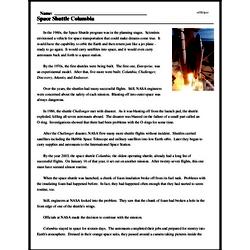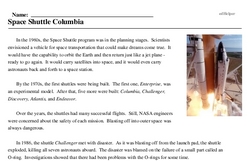Space Shuttle Columbia
In the 1960s, the Space Shuttle program was in the planning stages. Scientists envisioned a vehicle for space transportation that could make dreams come true. It would have the capability to orbit the Earth and then return just like a jet plane - ready to go again. It would carry satellites into space, and it would even carry astronauts back and forth to a space station.
By the 1970s, the first shuttles were being built. The first one, Enterprise, was an experimental model. After that, five more were built: Columbia, Challenger, Discovery, Atlantis, and Endeavor.
Over the years, the shuttles had many successful flights. Still, NASA engineers were concerned about the safety of each mission. Blasting off into outer space was always dangerous.
In 1986, the shuttle Challenger met with disaster. As it was blasting off from the launch pad, the shuttle exploded, killing all seven astronauts aboard. The disaster was blamed on the failure of a small part called an O-ring. Investigations showed that there had been problems with the O-rings for some time.




